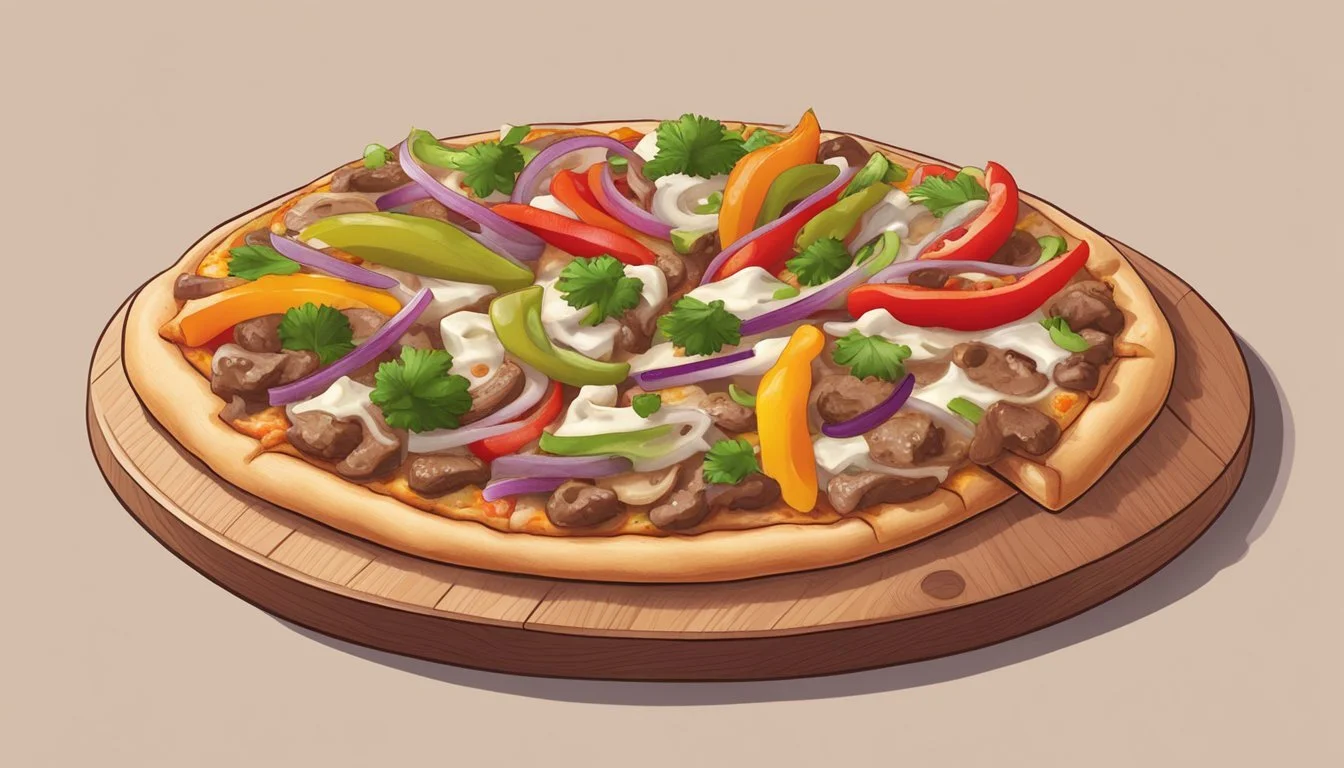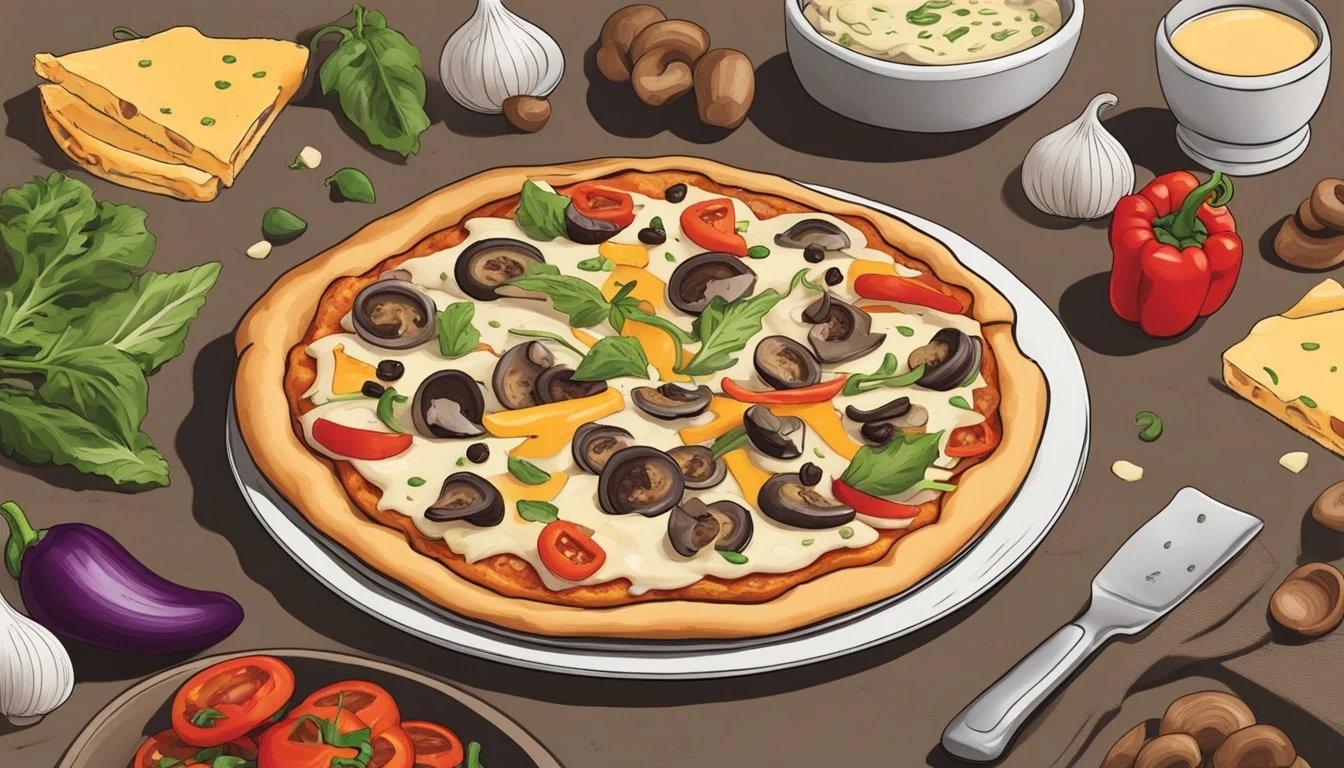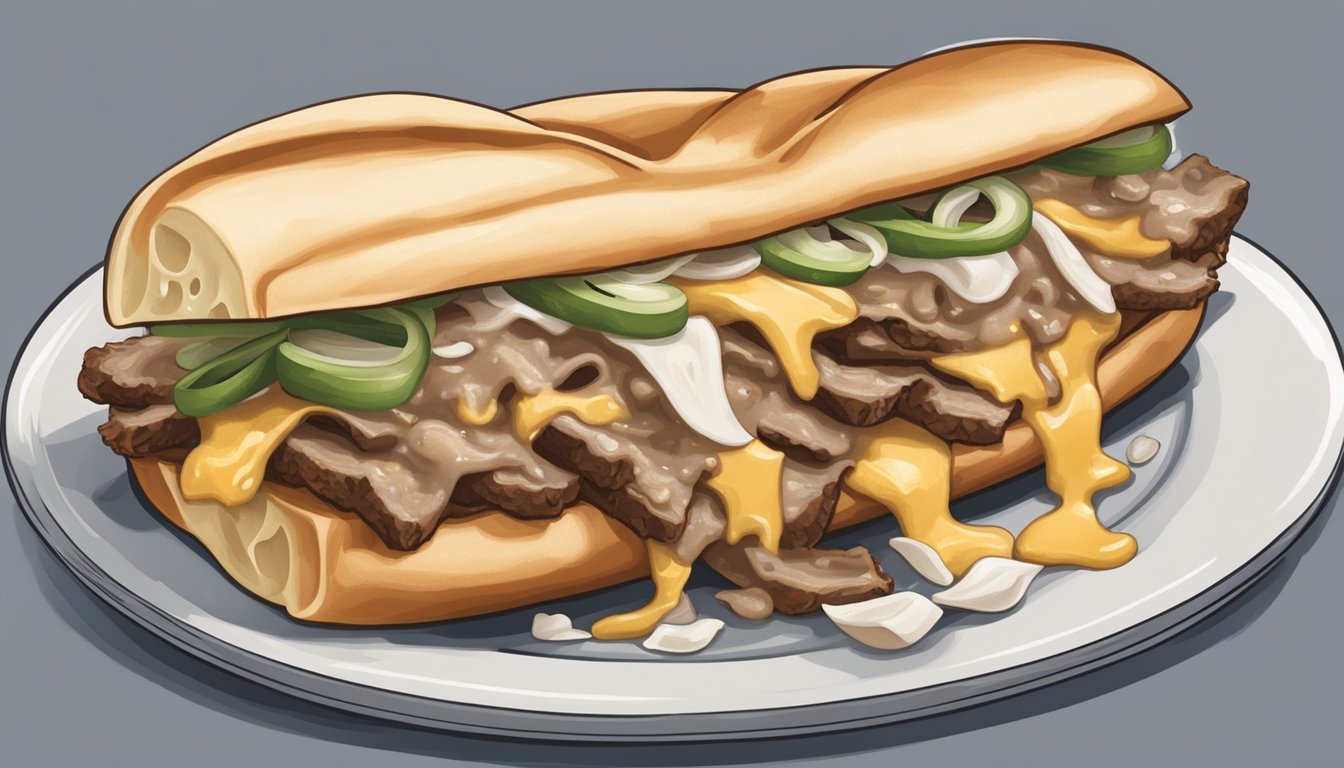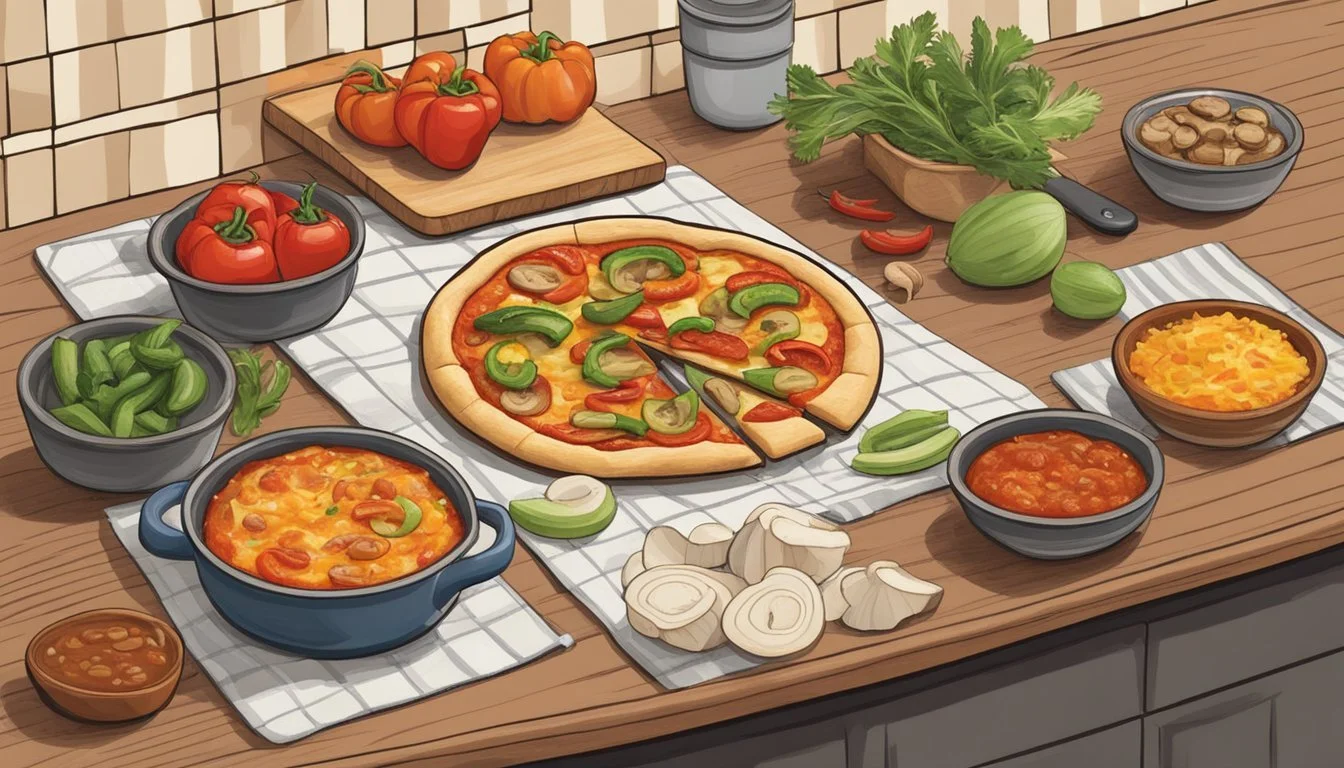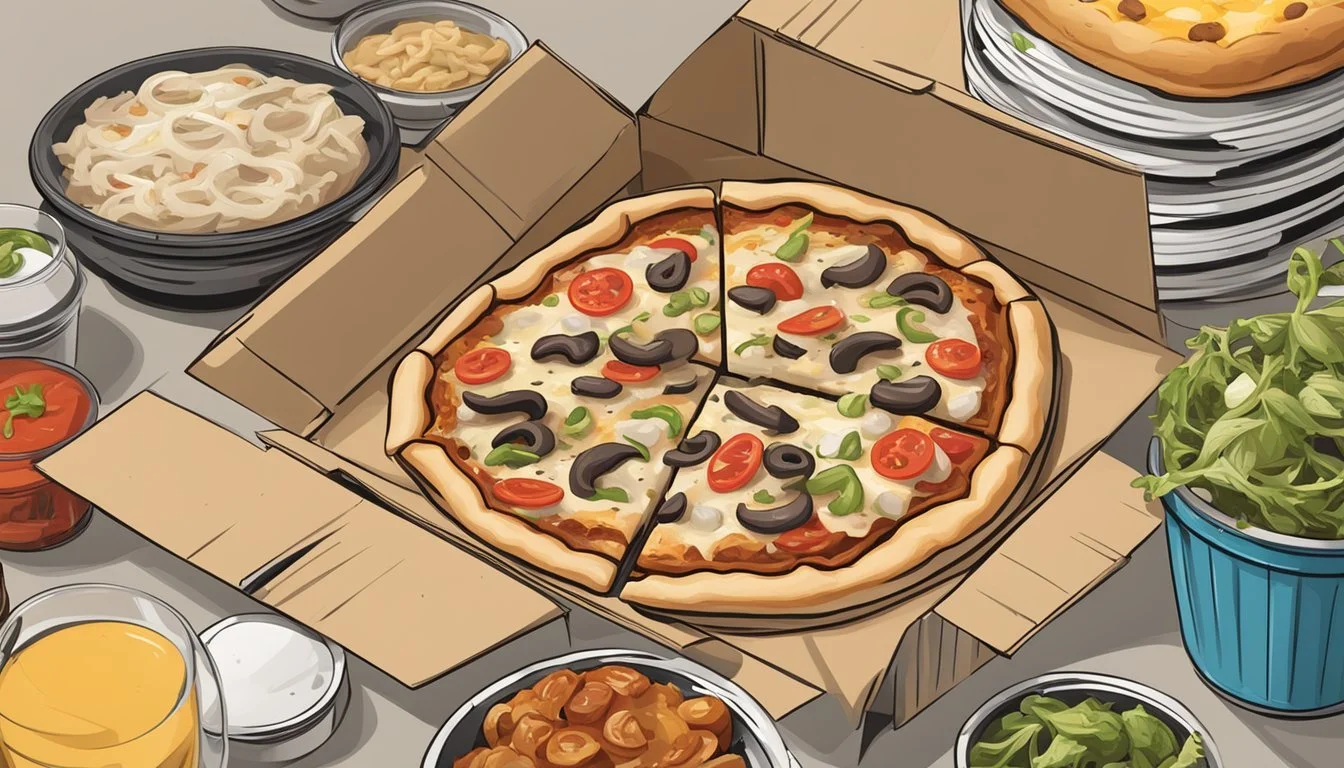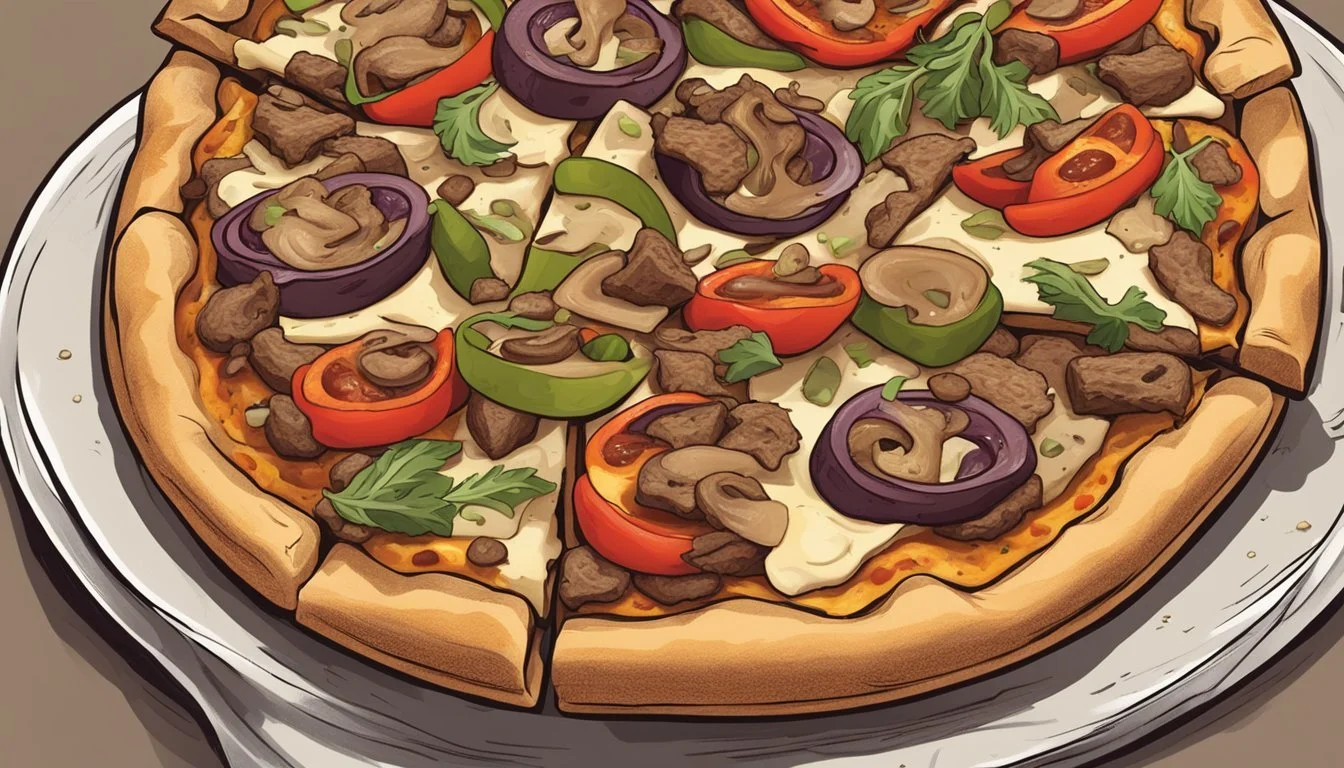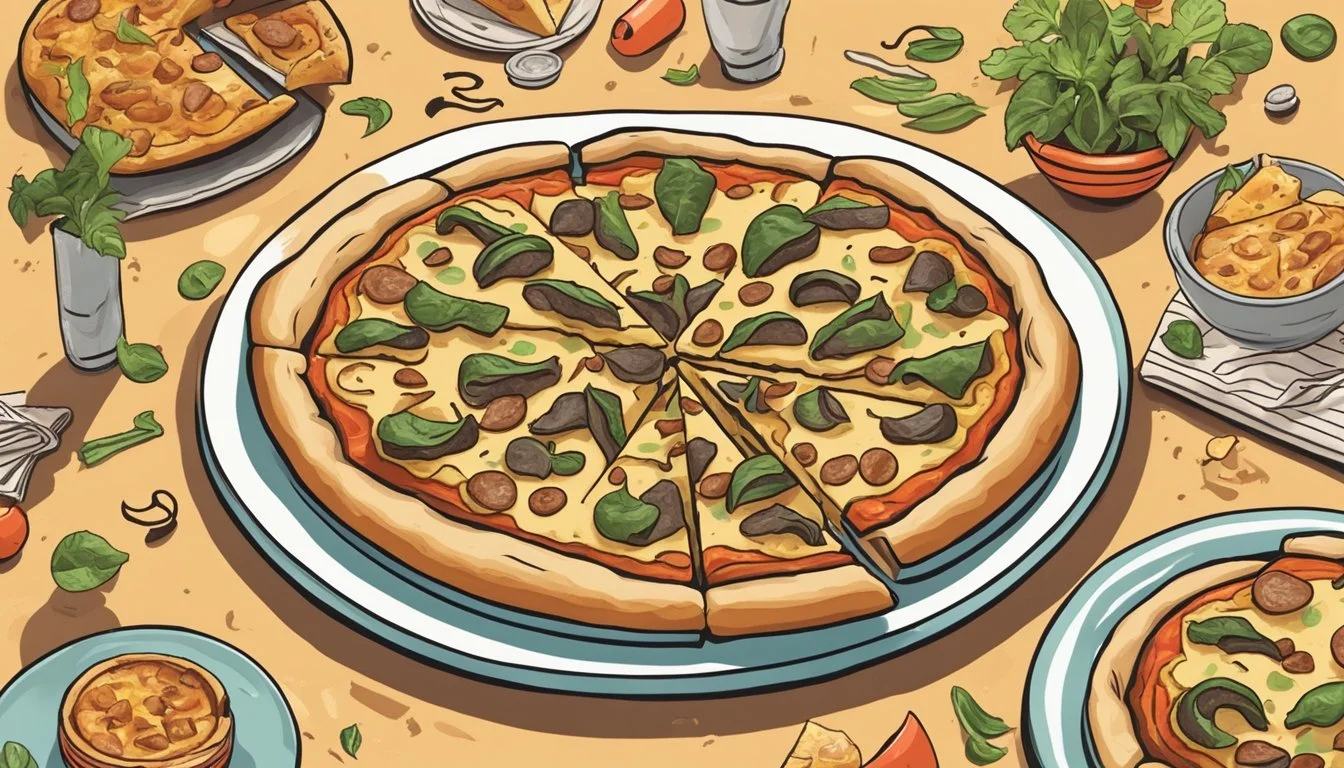Is Philly Cheesesteak Pizza Vegan?
Debunking Common Myths
A Philly cheesesteak pizza (What wine goes well with pizza?) combines the flavors of a classic Philadelphia cheesesteak sandwich with the beloved form of a pizza. Traditional ingredients include a pizza crust topped with steak slices, cheese, onions, and bell peppers. The fusion of these two comfort foods has garnered a following for its hearty taste and satisfying nature. However, questions arise for those adhering to a vegan diet, as the original components are not plant-based.
Vegan alternatives to the dish have emerged, adapting the Philly cheesesteak pizza to fit vegan preferences. These plant-based versions substitute the cheese and steak with non-animal derived products, ensuring that the essence of the dish remains, while aligning with vegan standards. Innovations in vegan products have led to the creation of meatless steak options and a variety of dairy-free cheeses that melt and stretch similar to traditional cheese.
The creation of a vegan Philly cheesesteak pizza requires careful consideration and selection of ingredients to ensure that every component complies with vegan principles. It involves replacing the standard crust with a vegan-friendly version, omitting ingredients like honey or dairy, and using toppings that are entirely plant-based. As the palate for vegan alternatives grows, so does the availability of vegan Philly cheesesteak pizzas in the culinary scene, making it a viable choice for those seeking a fusion of classic taste and vegan lifestyle.
Understanding Veganism
Veganism is a dietary and lifestyle choice centered around the exclusion of animal products. This section explores what it means to be vegan, the dietary benefits, how it influences food choices, common substitutes for animal products, and the ethical and environmental reasons for choosing a vegan lifestyle.
Defining 'Vegan'
A vegan is someone who does not consume or use animal products and by-products. This includes meat, dairy, eggs, and often extends to non-food items such as leather and wool. Vegan diets consist solely of plant-based foods, focusing on fruits, vegetables, legumes, grains, nuts, and seeds.
Health Benefits of a Vegan Diet
Individuals often turn to a vegan diet for its potential health benefits. A well-planned vegan diet is rich in protein, fiber, and essential nutrients while typically lower in calories, fat, cholesterol, and sodium, which can be beneficial for heart health and weight management. Such diets, however, need careful planning to avoid nutritional deficiencies.
Veganism and Food Choices
Veganism significantly changes an individual's food choices. Vegan comfort food is increasingly popular, allowing indulgence in favorites like pizzas and cheesesteaks without animal products. Vegan food options have expanded, with a wide variety of plant-based alternatives available.
Common Vegan Substitutes
Vegans utilize a range of substitutes to replace animal-derived ingredients. Among the most popular are:
Meat Substitutes: tofu, tempeh, seitan, (What wine goes well with seitan?) and soy curls
Dairy Alternatives: plant-based milks, vegan butter, and vegan cheese sauce
Vegan Cheese: made from nuts or soy
Vegan Meat: products designed to imitate meat flavors and textures
These substitutes help ensure a vegan diet can be as diverse as any other.
Ethical and Environmental Considerations
The decision to follow a vegan lifestyle often stems from ethical concerns related to animal welfare and environmental considerations. Producing animal-based foods typically requires more resources and contributes to higher greenhouse gas emissions compared to plant-based foods. Consequently, veganism is seen as a more environmentally sustainable choice.
Anatomy of a Philly Cheesesteak
The Philly cheesesteak is an iconic American sandwich, originating from Philadelphia, known for its hearty fillings and savory flavors. This section dissects its components, preparation methods, and variations.
Traditional Ingredients
Beef: Thinly sliced rib-eye or top round, traditionally chosen for its flavor and tenderness.
Cheese: Options include American cheese, provolone, and for the authentic experience, Cheez Whiz.
Hoagie Roll: A fresh, crusty roll that's dense enough to hold the ingredients without falling apart.
Onions: Typically, onions are sautéed until caramelized to add sweetness and depth of flavor.
Peppers: Green bell peppers are often included, sautéed to complement the onions.
Culinary Techniques
Sautéing Onions and Peppers: Onions and green bell peppers are cooked down to create a foundation of flavor.
Cooking the Beef: Meat is quickly cooked on a flat top grill or skillet, ensuring a savory crust with juicy interior.
Assembling the Sandwich: Ingredients are layered efficiently, with cheese melting over the hot beef, nestled in the hoagie roll.
The Role of Flavor and Texture
Marinade and Seasonings: Beef may be marinated or seasoned with garlic and spices for additional flavor.
Savory Balance: The mingling of seasoned beef, sweet caramelized onions, and rich cheese creates a well-rounded savory experience.
Texture Contrast: The slight crunch of the roll, tender beef, and the creamy cheese offers a satisfying mouthfeel.
Caloric and Nutritional Profile
Calories: A typical Philly cheesesteak contains a high caloric load, often exceeding 700 calories.
Macronutrients:
Fat: Significant due to cheese and beef, contributing to the taste and caloric count.
Carbohydrates: Predominantly from the hoagie roll, also providing energy.
Protein: Beef is a rich source, essential for a balanced diet.
Sodium: Levels may be high due to cheese and seasonings.
Popular Variations
Cheese Selection: Some prefer milder cheeses or even dairy-free alternatives.
Additional Toppings: Mushrooms, pickled peppers, and even pizza sauce are contemporary additions.
Health-Conscious Recipes: Leaner cuts of beef, low-fat cheese options, and whole grain rolls cater to those watching their diet.
Exploring Vegan Philly Cheesesteak
The vegan take on the classic Philly cheesesteak replaces traditional ingredients with plant-based alternatives without compromising on the iconic flavors and textures of the original sandwich.
Vegan Philly Cheesesteak Recipe Overview
Vegan Philly cheesesteak is a plant-based rendition of the traditional sandwich, where meat is typically replaced with high-protein alternatives like seitan or tofu. The key to an authentic taste lies in the preparation of these meat substitutes, often involving a marinade that may include soy sauce, vegan Worcestershire sauce, garlic powder, and black pepper. The sandwich is then assembled with sautéed veggies such as green bell peppers and onions, topped with vegan cheese or vegan cheese sauce, and served on a long hoagie roll.
Ingredient Swaps for Veganization
Several ingredient swaps are made to "veganize" the classic recipe:
Meat Substitute: Seitan, tofu, or even portobello or button mushrooms are options to mimic the texture and protein content of steak.
Vegan Cheese: Many recipes opt for store-bought vegan cheese slices or a homemade vegan cheese sauce made with ingredients like cashews, nutritional yeast, and plant-based milk.
Vegan Butter: Used to sauté vegetables, providing richness typically offered by dairy butter.
Textural and Flavor Considerations
The success of a vegan Philly cheesesteak hinges on achieving a balance between texture and flavor that closely resembles the original. Seitan offers a chewy, meat-like texture, while tofu can be pressed and cooked to a firm consistency. Marinating these substitutes is essential for infusing robust flavors. A combination of spices such as onion powder, paprika, and black pepper alongside aromatic sautéed green bell peppers and onions helps create a symphony of flavors that characterizes the sandwich.
Nutritional Comparison
A vegan Philly cheesesteak can be healthier than the traditional version, often lower in calories, fat, and sodium, while being higher in fiber. Here's a basic comparison:
Nutrients Traditional Cheesesteak Vegan Cheesesteak Protein High (beef) High (seitan/tofu) Fiber Low Higher (veggies, meat substitute) Calories Higher Lower (depends on cheese and butter used) Fat Higher (cheese, beef) Lower (vegan cheese, plant-based proteins) Carbohydrates Moderate Moderate (primarily from the roll) Sugar Low Low Sodium Higher Lower (adjusted as per recipe)
Opting for vegan versions not only caters to dietary preferences but can also be a step toward a healthier option.
Is Philly Cheesesteak Pizza Vegan?
When it comes to indulging in the classic flavors of a Philly cheesesteak pizza, those following a vegan diet may be curious if this comforting dish can fit into their lifestyle.
Breaking Down Philly Cheesesteak Pizza
Philly cheesesteak pizza traditionally combines the elements of the iconic sandwich with the universally loved format of pizza. The classic version is not vegan, featuring a rich blend of beef steak slices, melted cheese, and often toppings like onions and green bell peppers. The base is a pizza crust, typically made from flour, yeast, water, and oil.
Modifications for a Vegan Pizza
To transform this dish into a vegan-friendly meal, several key substitutions are necessary:
Meat Substitute: Replace the beef steak slices with plant-based alternatives, such as marinated mushrooms or commercially available vegan meat.
Cheese: Opt for vegan cheese slices or a vegan cheese sauce made from nuts or soy.
Other Ingredients: Ensure that the pizza dough and any additional toppings are free of animal products.
Steps to Prepare Vegan Philly Cheesesteak Pizza
For a vegan Philly cheesesteak pizza, follow these steps:
Preheat the oven as required, usually between 375°F-450°F.
Prepare the pizza dough and spread it out onto a baking sheet.
Top with your chosen vegan meat substitute and sautéed veggies like onions and green peppers.
Add vegan cheese slices or dollops of vegan cheese sauce.
Bake until the crust is crispy, the toppings are cooked, and the vegan cheese has melted, typically for about 10-15 minutes.
Taste and Presentation Tips
To ensure your pizza is as delicious as it is appealing, consider these tips:
Season well: Generously season the meat substitute and vegetables to mimic the savory taste of traditional Philly cheesesteak.
Use a variety of vegan cheeses for a more complex flavor profile.
Present with a garnish of fresh herbs or a drizzle of vegan cheese sauce for an Instagram-worthy look.
Serving and Pairing Suggestions
This pizza can stand as a comfort food meal on its own or be served with:
A side of vegan coleslaw or French fries for a complete meal experience.
Steamed or sautéed veggies for a healthier side option.
Consider meal prep by making extra pizza to enjoy throughout the week.
Creating a vegan version of Philly cheesesteak pizza allows diners to enjoy a classic comfort food with a plant-based twist, suitable for any occasion and appreciated by vegans and non-vegans alike.
Kitchen Tools and Techniques
In creating a vegan Philly cheesesteak pizza, one must consider the right combination of kitchen tools and techniques. The tools facilitate the preparation of ingredients, and the techniques ensure that flavors are well-developed.
Essential Cooking Utensils
For the preparation of a vegan Philly cheesesteak pizza, here is a curated list of utensils:
Spoons: Required for stirring and mixing ingredients.
Skillet: A large skillet is pivotal for sautéing onions and other vegetables to achieve a caramelized finish.
Mixing Bowl: A large mixing bowl is essential for combining the marinade ingredients thoroughly.
Spatula: To help flip and move ingredients in the skillet without them breaking.
Saucepan: A saucepan is useful for preparing vegan cheese sauce, where one would need to whisk the ingredients together.
Whisk: Necessary for creating a smooth and even cheese sauce.
Baking Sheet/Pizza Stone: Important for baking the pizza, allowing for a crisp crust.
Cooking Techniques for Vegans
The techniques employed in cooking can enhance the flavors and textures of plant-based ingredients:
Marinade Preparation: It involves mixing oil, vinegar, seasonings, and other ingredients in a bowl to create a flavorful liquid. This is used to soak protein substitutes like seitan or soy curls to imbue them with a rich flavor.
Sautéing: This technique is utilized for cooking the onions and other vegetables in a skillet. It requires one to cook them over medium-high heat until they are soft and have a light brown sear which concentrates their flavors.
Baking: A key part of assembling the pizza involves baking the crust with toppings in a preheated oven until the crust is crispy and the toppings are heated through.
By combining these tools and techniques, a cook can confidently produce a scrumptious, non-traditional spin on classic comfort food.
Storage and Leftovers
Proper storage and reheating techniques ensure that Philly cheesesteak pizza, especially when vegan, retains its flavor and texture. Utilizing the correct containers and methods can greatly affect the dish's shelf life and quality upon reheating.
Best Practices for Storage
To preserve the quality of vegan Philly cheesesteak pizza, they should ensure the leftovers are cooled to room temperature before placing them in the refrigerator. Using airtight containers is best to prevent the pizza from drying out or absorbing odors from the fridge. If tofu or seitan were used as meat substitutes, these proteins should be stored carefully as they can become soggy if not sealed properly.
Containers: Airtight, shallow containers
Preparation: Allow pizza to cool; avoid stacking slices
Additives: A light brush of vegetable oil or vegan butter can keep the crust from drying
Reheating Tips
For reheating, they should opt for an oven or toaster oven over a microwave to maintain the pizza's texture. Placing the pizza on a baking sheet and reheating at 350 degrees Fahrenheit usually yields the best result. The reheating process typically takes about 10 minutes, until the pizza is thoroughly heated and the crust is crispy.
Methods:
Oven: Preheat to 350°F, reheat for 10 minutes
Toaster oven: Similar to oven, may require less time
Don'ts: Avoid microwaving to prevent a soggy crust
Shelf Life of Vegan Ingredients
Vegan components like vegetable broth, tofu, and seitan have varying shelf lives which reflect on the pizza's overall freshness. When stored correctly in the refrigerator, the pizza typically remains good for 3-5 days. They should always check for any signs of spoilage like an off-smell or discoloration before consumption.
Ingredients:
Tofu: 3-5 days in the refrigerator
Seitan: 5-7 days in the refrigerator
Broth-based sauces: Best used within 2-3 days
Meal prep enthusiasts can also freeze individual slices, wrapped in foil and placed in freezer bags, for longer storage. However, they should be aware that freezing and thawing may affect the texture of the pizza, particularly the crust and meat substitutes.
Nutritional Considerations
Making Philly cheesesteak pizza vegan involves replacing traditional ingredients with plant-based alternatives, thereby altering its nutritional profile. This section explores how these substitutions can affect the macros and overall nutrients while ensuring a balanced meal.
Balancing a Nutritious Vegan Meal
Vegan meals can provide all the essential nutrients the body needs, but it requires careful selection of ingredients. When creating a vegan Philly cheesesteak pizza, one should aspire to include a variety of protein-rich sources alongside fiber-packed vegetables to achieve a balanced dish. Not only does fiber aid in digestion, but it also contributes to the feeling of fullness.
Protein: Incorporate tofu, tempeh, seitan, or soy curls as meat substitutes that are dense in protein.
Fiber: Add vegetables like onions and green peppers to elevate the fiber content.
Nutrients: Introduce toppings such as avocado slices for healthy fats, vitamins, and minerals.
Understanding Macros and Calories
The caloric content and macronutrient breakdown—proteins, fats, and carbohydrates—are central to the nutritional value of a meal. Vegan cheeses and meat alternatives like seitan generally contain less fat than their animal-derived counterparts, hence potentially reducing the total calorie count.
Calories: A slice of vegan Philly cheesesteak pizza typically has fewer calories due to the omission of high-fat cheese and meat.
Fat: Opt for heart-healthier fats like olive or avocado oil for cooking.
Carbohydrates: Whole-grain pizza dough can provide complex carbs for sustained energy.
Sugar: Keep added sugars minimal by using natural ingredients and avoiding excess sauces.
Ingredients for Healthier Alternatives
The choice of ingredients greatly impacts the healthiness of the vegan Philly cheesesteak pizza. Each component should contribute to the meal's nutritional density.
Vegan Cheese: Seek out vegan cheese options low in saturated fat and free from artificial additives.
Plant-Based Meats: Use minimally processed meat substitutes for a cleaner ingredient list and better health profile.
Cooking Oils: Moderate the use of oils; even healthier oils like olive and avocado oil are high in calories, so use them sparingly.
Creative Twists and Variations
In the quest to craft a vegan Philly cheesesteak pizza, chefs have demonstrated inventive flair. The traditional elements of a cheesesteak—cheese, peppers, onions—are reimagined with plant-based alternatives, ensuring that the essence of the beloved sandwich is honored while providing new taste experiences.
Experimenting with Toppings and Fillings
The foundation of any vegan Philly cheesesteak pizza rests on its toppings. Classic onions and green or bell peppers are sautéed to perfection, often joined by portobello mushrooms for a meaty texture. Bold creators might add avocado slices for creaminess or a splash of soy sauce or tamari for depth. A favorite cheese alternative is vegan mayo, which can be used to create a rich base layer or drizzled on top.
Cheese Alternatives: Vegan shredded cheese, nutritional yeast, vegan cheese sauce
Protein: Marinated seitan, crumbled tofu, rehydrated soy curls
Add-ons: Jalapeños, artichokes, sun-dried tomatoes
Fusion of Cuisines and Flavors
A fusion approach weaves international flavors into the iconic Philly cheesesteak. Some daring combinations might feature Italian seasoning or oregano, anchoring the pizza with herby undertones. A cross-cultural creation could include an Asian twist with a hint of vegan Worcestershire sauce for umami richness, creating a flavor profile that dares to differ from the original.
Apron’s Suggestion:
Asian Influence: A mix of hoisin sauce and vegan mayo as base, topped with seitan strips marinated in tamari and sprinkled with sesame seeds.
Mexican Makeover: Vegan cheddar, seasoned black beans, corn, and a zesty vegan sour cream drizzle.
Themed Philly Cheesesteak Creations
Tailored vegan Philly cheesesteak pizzas can surface on menus across various occasions. For a game day treat, a hearty pizza layered with vegan cheesesteak sandwich components can be a crowd-pleaser. Meal prep can also be made efficient and exciting by preparing individual pizzas topped with different variations of vegan cheesesteak fillings, allowing for a diverse range throughout the week. These themed creations become a joyous affair on social platforms like Instagram, where food enthusiasts celebrate inventive recipes and snap eye-catching photos of their colorful, savory masterpieces.
Occasion Ideas:
Birthday Bash: Customizable mini pizzas with a selection of toppings for guests to choose from.
Summer Picnic: Portable vegan cheesesteak sandwich wraps with a side of tangy, herb-infused vegan mayo dip.
Conclusion
In assessing whether Philly cheesesteak pizza can be considered vegan, one must examine the components that typically constitute a Philly cheesesteak—a sandwich known for its combination of sliced beef, melted cheese, and a long hoagie roll—and adapt them to vegan standards. Vegan Philly cheesesteak substitutes address each of these elements with plant-based alternatives, such as seitan or soy curls for beef, and cashew or soy-based cheeses for dairy cheese.
For the pizza variant, the same principles apply. The base—pizza dough—is generally vegan, made from flour, water, yeast, and salt. However, traditional Philly cheesesteak pizzas include cheese and steak which are not vegan. A vegan Philly cheesesteak pizza must use dairy-free cheese and plant-based meat replacements to align with vegan practices.
The toppings may include sautéed onions and green peppers, staples in the original sandwich, ensuring the pizza retains the classic Philly cheesesteak flavor profile. It’s essential to note that care must be taken with any additional toppings or condiments to ensure they do not contain animal-derived ingredients.
Individuals following a vegan diet can enjoy a Philly cheesesteak pizza by carefully selecting appropriate vegan alternatives for each non-vegan ingredient, proving that this iconic dish can be adapted to suit a variety of dietary preferences without compromising on taste.

